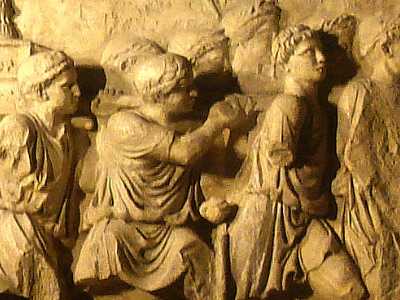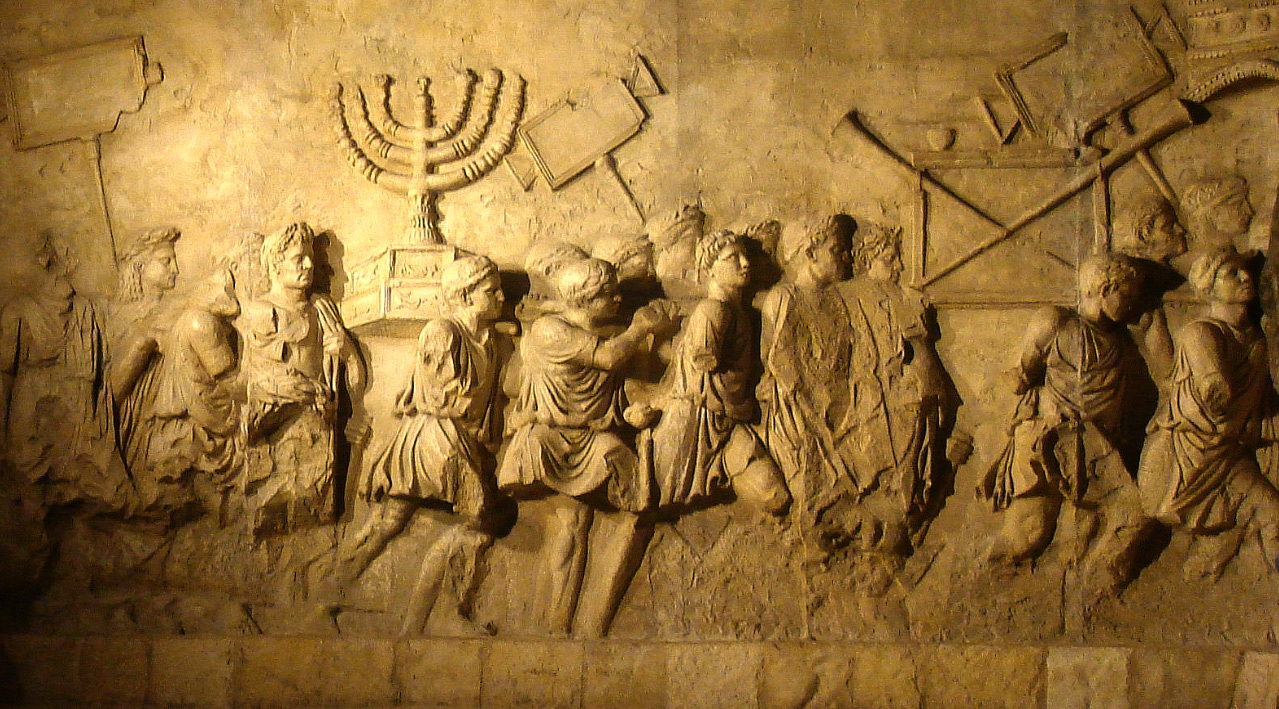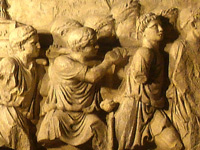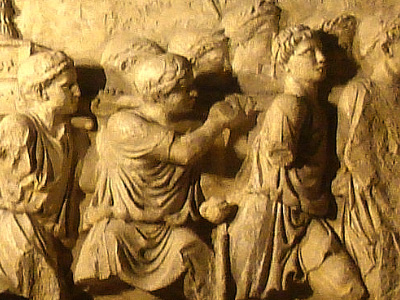Vandalic War (533-534 AD)

Aftermath
Belisarius' triumph
Belisarius would not remain long in Africa to consolidate his success, as a number of officers in his army, in hopes of their own advancement, sent messengers to Justinian claiming that Belisarius intended to establish his own kingdom in Africa. Justinian then gave his general two choices as a test of his intentions: he could return to Constantinople or remain in Africa. Belisarius, who had captured one of the messengers and was aware of the slanders against him, chose to return. He left Africa in the summer, accompanied by Gelimer, large numbers of captured Vandals—who were enrolled in five regiments of the Vandali Iustiniani ("Vandals of Justinian") by the emperor—and the Vandal treasure, which included many objects looted from Rome 80 years earlier, including the imperial regalia and the menorah of the Second Temple. In Constantinople, Belisarius was given the honour of celebrating a triumph—the first to be celebrated in Constantinople since its foundation and the first granted to a private citizen in over five and a half centuries -and described by Procopius:
And there was booty—first of all, whatever articles are wont to be set apart for the royal service—thrones of gold and carriages in which it is customary for a king's consort to ride, and much jewelry made of precious stones, and golden drinking cups, and all the other things which are useful for the royal table. And there was also silver weighing many thousands of talents and all the royal treasure amounting to an exceedingly great sum, and among these were the treasures of the Jews, which Titus, the son of Vespasian, together with certain others, had brought to Rome after the capture of Jerusalem. [...] And there were slaves in the triumph, among whom was Gelimer himself, wearing some sort of a purple garment upon his shoulders, and all his family, and as many of the Vandals as were very tall and fair of body. And when Gelimer reached the hippodrome and saw the emperor sitting upon a lofty seat and the people standing on either side and realized as he looked about in what an evil plight he was, he neither wept nor cried out, but ceased not saying over in the words of the Hebrew scripture: "Vanity of vanities, all is vanity." And when he came before the emperor's seat, they stripped off the purple garment, and compelled him to fall prone on the ground and do obeisance to the Emperor Justinian. This also Belisarius did, as being a suppliant of the emperor along with him.
— Procopius, The Vandalic War, II.9
Gelimer was given an ample estate in Galatia, and would have been raised to patrician rank if he had not steadfastly refused to renounce his Arian faith. Belisarius was also named consul ordinarius for the year 535, allowing him to celebrate a second triumphal procession, being carried through the streets seated on his consular curule chair, held aloft by Vandal warriors, distributing largesse to the populace from his share of the war booty.

The Menorah of the Temple of Jerusalem, shown carried in the triumphal procession of Titus along with spoils from the Temple on the Arch of Titus in Rome

The Menorah of the Temple of Jerusalem, shown carried in the triumphal procession of Titus along with spoils from the Temple on the Arch of Titus in Rome
( Click image to enlarge)
Re-establishment of Roman rule in Africa and the Moorish Wars
Immediately after Tricamarum, Justinian hastened to proclaim the recovery of Africa:
Our predecessors did not deserve this favor of God, as they were not only not permitted to liberate Africa, but even saw Rome itself captured by the Vandals, and all the Imperial insignia taken from thence to Africa. Now, however, God, in his mercy, has not only delivered Africa and all her provinces into Our hands, but the Imperial insignia as well, which, having been removed at the capture of Rome, He has restored to us.
— Codex Iustinianus, I.XXVII
The emperor was determined to restore the province to its former extent and prosperity—indeed, in the words of J.B. Bury, he intended "to wipe out all traces of the Vandal conquest, as if it had never been, and to restore the conditions which had existed before the coming of Geiseric". To this end, the Vandals were barred from holding office or even property, which was returned to its former owners; most Vandal males became slaves, while the victorious Roman soldiers took their wives; and the Chalcedonian Church was restored to its former position while the Arian Church was dispossessed and persecuted. As a result of these measures, the Vandal population was diminished and emasculated. It gradually disappeared entirely, becoming absorbed into the broader provincial population. Already in April 534, before the surrender of Gelimer, the old Roman provincial division along with the full apparatus of Roman administration was restored, under a praetorian prefect rather than under a diocesan vicarius, since the original parent prefecture of Africa, Italy, was still under Ostrogothic rule. The army of Belisarius was left behind to form the garrison of the new prefecture, under the overall command of a magister militum and several regional duces. Almost from the start, an extensive fortification programme was also initiated, including the construction of city walls as well as smaller forts to protect the countryside, whose remnants are still among the most prominent archaeological remains in the region.
Despite Justinian's intentions and proclamations, however, Roman control over Africa was not yet secure. During his campaign, Belisarius had secured most of the provinces of Byzacena, Zeugitana and Tripolitania. Further west, on the other hand, imperial control extended in a series of strongholds captured by the fleet along the coast as far as Constantine, while most of the inland areas of Numidia and Mauretania remained under the control of the local Moorish tribes, as indeed had been the case under the Vandal kings. The Moors initially acknowledged the Emperor's suzerainty and gave hostages to the imperial authorities, but they soon became restive and rose in revolt. The first imperial governor, Belisarius' former domesticus Solomon, who combined the offices of both magister militum and praetorian prefect, was able to score successes against them and strengthen Roman rule in Africa, but his work was interrupted by a widespread military mutiny in 536. The mutiny was eventually subdued by Germanus, a cousin of Justinian, and Solomon returned in 539. He fell, however, in the Battle of Cillium in 544 against the united Moorish tribes, and Roman Africa was again in jeopardy. It would not be until 548 that the resistance of the Moorish tribes would be finally broken by the talented general John Troglita.
HISTORY

RESOURCES
This article uses material from the Wikipedia article "Vandalic War (533-534 AD)", which is released under the Creative Commons Attribution-Share-Alike License 3.0.
© Stories Preschool. All Rights Reserved.









